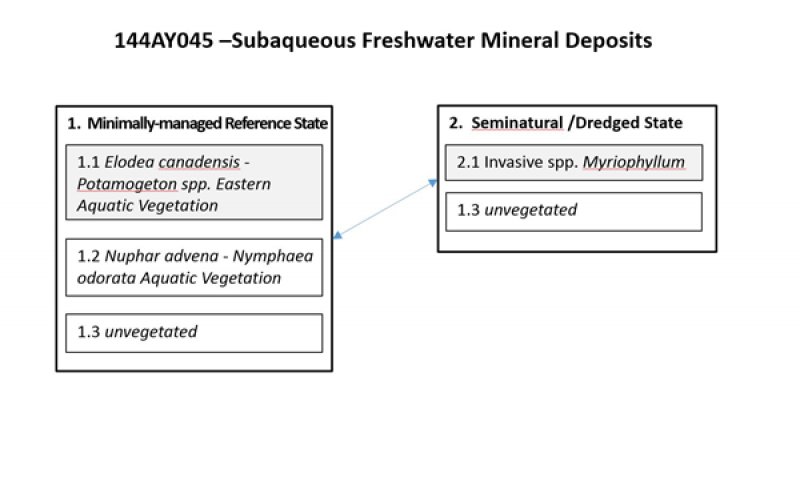
Natural Resources
Conservation Service
Ecological site R144AY045RI
Subaqueous Freshwater Mineral Deposits
Last updated: 10/04/2024
Accessed: 11/23/2024
General information
Provisional. A provisional ecological site description has undergone quality control and quality assurance review. It contains a working state and transition model and enough information to identify the ecological site.
MLRA notes
Major Land Resource Area (MLRA): 144A–New England and Eastern New York Upland, Southern Part
MLRA 144A: New England and Eastern New York Upland, Southern Part
The eastern half of the eastern part of this MLRA is in the Seaboard Lowland Section of the New England Province of the Appalachian Highlands. The western half of the eastern part and the southeastern half of the western part are in the New England Upland Section of the same province and division. The northwestern half of the western part is in the Hudson Valley Section of the Valley and Ridge Province of the Appalachian Highlands. This MLRA is a very scenic area of rolling to hilly uplands that are broken by many gently sloping to level valleys that terminate in coastal lowlands. Elevation ranges from sea level to 1,000 feet (0 to 305 meters) in much of the area, but it is 2,000 feet (610 meters) on some hills. Relief is mostly about 6 to 65 feet (2 to 20 meters) in the valleys and about 80 to 330 feet (25 to 100 meters) in the uplands.
This area has been glaciated and consists almost entirely of till hills, drumlins, and bedrock-controlled uplands with a mantle of till. It is dissected by narrow glacio-fluvial valleys. The southernmost boundary of the area marks the farthest southward extent of Wisconsinian glaciation on the eastern seaboard. The river valleys and coastal plains are filled with glacial lake sediments, marine sediments, and glacial outwash. The bedrock in the eastern half of the area consists primarily of igneous and metamorphic rocks of early Paleozoic age. Granite is the most common igneous rock, and gneiss, schist, and slate are the most common metamorphic rocks. In the parts of the MLRA in eastern and southeastern New York, Devonian- to Pennsylvanian-age sandstone, shale, and limestone are dominant. Carbonate rocks, primarily dolomite and limestone, are the dominant kinds of bedrock in the part of this MLRA in northwestern Connecticut.
Ecological site concept
The site consists of subaqueous soils permanently submerged beneath 0 to about 3 meters of water on submerged landscapes of freshwater ponds, lakes, and reservoirs. Slope ranges from 0 to 5 percent. Representative soils are Aquapaug, Burlingame, and Shannock.
Aquapaug soils formed in over 100 cm of sandy outwash material. Burlingame soils formed in mixed lacustrine material overlying till. They are typically underlain by supraglacial meltout or lodgement till. Shannock soils formed in a thick mantle of recent lacustrine sediments over glacial lacustrine and/or glaciofluvial sediments.
Areas of this soil are used for recreational fishing, swimming, and aquatic wetland habitat. Vegetation includes waterseed (Elodea canadensis), bladderwort (Utricularia spp.), fanwort (Cabomba caroliniana), variable milfoil (Myriophyllum heterophyllum), white water lily (Nymphaea ordorata), and yellow water lily (Nuphar variegatum).
Similar sites
| F144AY037MA |
Moist Dense Till Uplands |
|---|
Table 1. Dominant plant species
| Tree |
Not specified |
|---|---|
| Shrub |
Not specified |
| Herbaceous |
(1) Elodea canadensis |
Click on box and path labels to scroll to the respective text.

